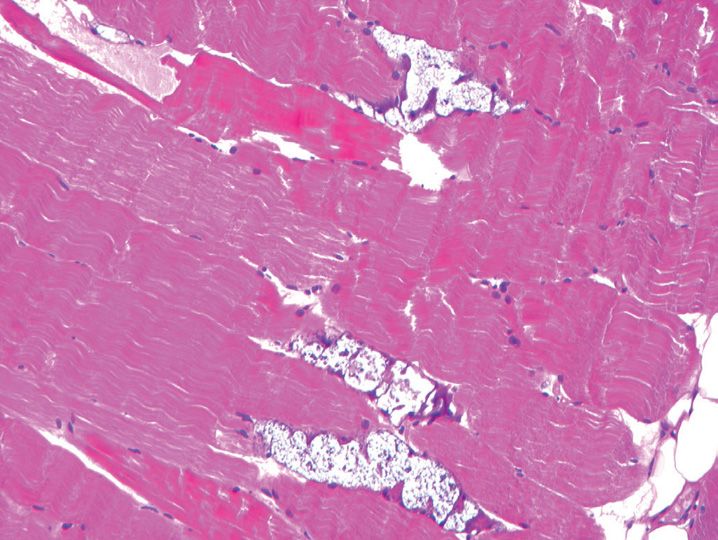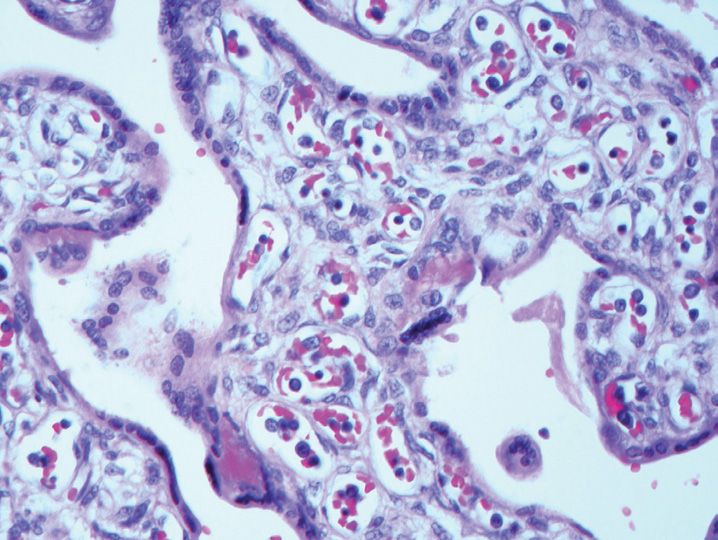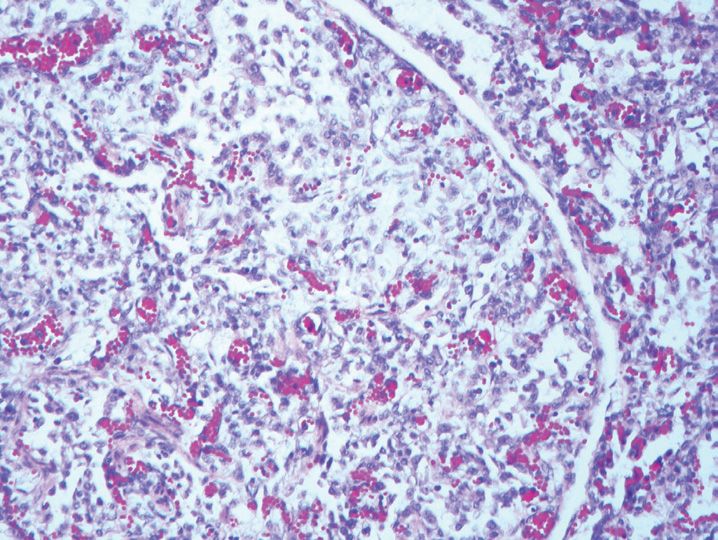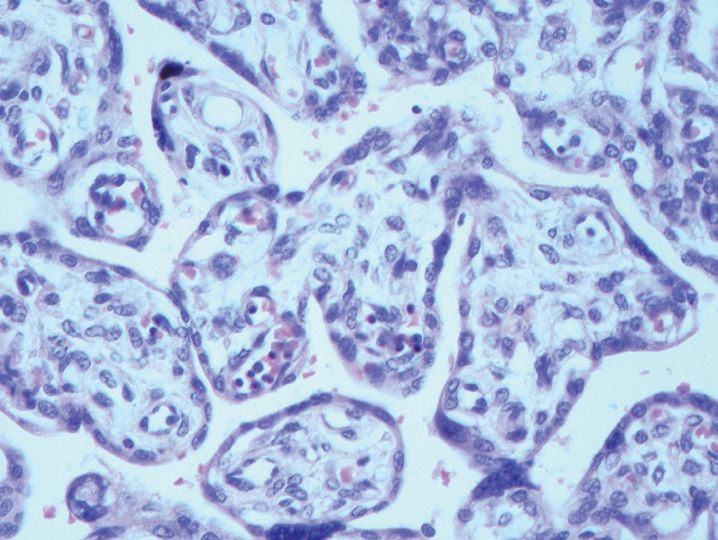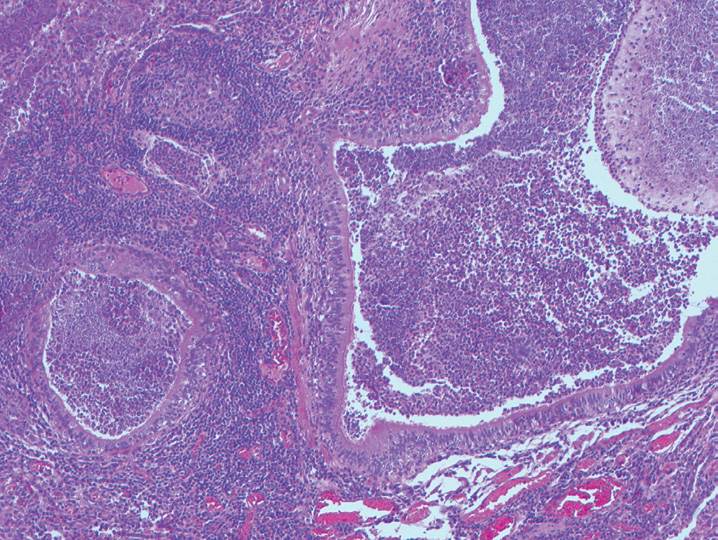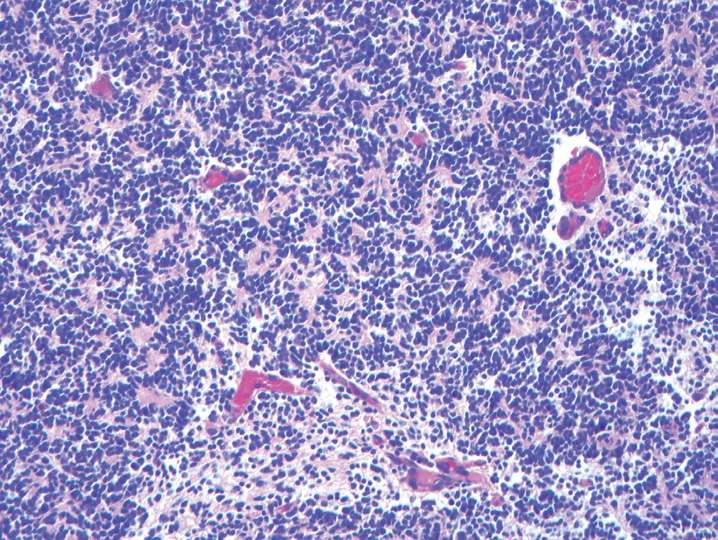FIGURE 21-1
(A) Autosomal-dominant disorder.
(B) Defect in glucocerebrosidase.
(C) Increased cytokines IL-1 and IL-6 secreted by macrophages.
(D) Patients often are thrombocytopenic.
(E) Splenomegaly is a common finding.
16. The muscle biopsy seen in Figure 21-2 in a 42-year-old woman shows scattered fibers with vacuoles filled with PAS-positive material. The vacuoles also show positive staining with acid phosphatase. The best diagnosis for this patient is a deficiency in which of the following?
(B) Debranching enzyme
(C) Glucose-6-phophatase
(D) Myophosphorylase
(E) Phosphofructokinase
17. A 26-year-old man presents with painful muscle cramps associated with strenuous exercise and myoglobinuria. The patient has an elevated serum creatine level and a normal serum lactate level with exercise. The patient has a deficiency in which of the following?
(A) Acid maltase
(B) Debranching enzyme
(C) Glucose-6-phosphatase
(D) Myophosphorylase
(E) Phosphofructokinase
18. In studying chromosomes by karyotyping, chromosomes are typically examined in which phase?
(A) Anaphase
(B) Interphase
(C) Metaphase
(D) Prophase
(E) Telophase
19. A 2-year-old male has a karyotype performed. The result of his karyotype was 46,XY/47,XY, +21. Which of the following is the best assessment of this child’s condition?
(A) Down syndrome
(B) Down syndrome mosaic
(C) Edwards syndrome
(D) Edwards syndrome mosaic
(E) Patau syndrome
20. Which of the following is least likely to be associated with Edwards syndrome?
(A) Cleft lip and palate
(B) Congenital heart defects
(C) Micrognathia
(D) Prominent occiput
(E) Rocker bottom feet
21. All of the following features are commonly encountered in a patient who has a karyotype of 46,XX+13, der (13;14) (q10;q10) except
(A) Microcephaly with mental retardation
(B) Polydactyly
(C) Rocker bottom feet
(D) Simian crease
(E) Umbilical hernia
22. In examining the placenta of a 38-week gestational age newborn, atypical cells are noted in the fetal circulation as seen in Figure 21-3. You recommend that a bone marrow biopsy be done. Which of the following conditions is the patient most likely to have?
(A) Klinefelter syndrome
(B) Trisomy 13
(C) Trisomy 18
(D) Trisomy 21
(E) Turner syndrome
23. A 17-year-old male presents with delayed sexual development and a diagnosis of Klinefelter syndrome is being entertained. All of the following are associated with this condition except
(A) Higher risk for breast cancer
(B) Higher risk for coarctation of the aorta
(C) Higher risk for mitral valve prolapse
(D) Higher risk for systemic lupus erythematosus
(E) Higher risk for type 2 diabetes
24. All of the following conditions are examples of trinucleotide repeat disorders except
(A) Fragile-X syndrome
(B) Friedreich ataxia
(C) Huntington disease
(D) Myotonic dystrophy
(E) Spinal muscular atrophy
25. Mitochondrial DNA encodes for enzymes that are involved with oxidative phosphorylation. Which of the following organs is least dependent on oxidative phosphorylation for functioning?
(A) Brain
(B) Cardiac muscle
(C) Liver
(D) Skeletal muscle
(E) Spleen
26. All of the following are true regarding Prader–Willi syndrome except
(A) Chromosome 15 deletion
(B) Hypotonia
(C) Inappropriate laughter
(D) Obesity
(E) Short stature
27. All of the following are indications for prenatal genetic analysis except
(A) Abnormal alpha-fetoprotein (AFP) and estriol levels
(B) Fetus with ultrasound abnormality
(C) Maternal age 37 years
(D) Parent who is a carrier of an autosomal-recessive disorder
(E) Parent who is a carrier of a Robertsonian translocation
28. Postnatal genetic analysis in a patient with multiple congenital anomalies is usually performed on which of the following specimens?
(A) Bone marrow tissue
(B) Peripheral blood lymphocytes
(C) Peripheral blood red cells
(D) Skin
(E) Umbilical cord/placental tissue
29. A sensitivity control is required with which of the following molecular tests?
(A) Chromogenic in situ hybridization
(B) Fluorescence in situ hybridization
(C) Gene rearrangement Southern blots
(D) Quantitative polymerase chain reaction
(E) Sanger DNA sequencing
30. All of the following are acceptable routes for laboratory proficiency testing for molecular assays except
(A) “Chart review” or another clinical correlation with test results
(B) College of American Pathologists program
(C) Performance of at least 100 tests before “going live”
(D) Splitting of samples with another laboratory
(E) Testing of samples against another in-house method
31. All of the following methods of cell lysis in preparing specimens for molecular testing are effective except
(A) Alcohol
(B) Boiling
(C) Chaotropic salt solution
(D) Detergent
(E) Thio reduction
32. Maximal spectrophotometric absorbance for nucleotides occurs at which wavelength
(A) 180 nm
(B) 200 nm
(C) 240 nm
(D) 260 nm
(E) 280 nm
33. Reverse transcription-polymerase chain reaction uses which of the following as starting material for in vitro nucleic acid amplification?
(A) Complementary DNA (cDNA)
(B) Double-stranded DNA
(C) Protein
(D) RNA
(E) Single-stranded DNA
34. All of the following are advantages of real-time polymerase chain reaction (PCR) over conventional PCR except
(A) Ability to perform melting curve analysis
(B) A narrow dynamic range
(C) More reproducible
(D) No need for postamplification processing
(E) Reaction tubes remain closed, decreasing risk of amplicon contamination
35. All of the following are true regarding polymerase chain reaction (PCR) and its diagnostic use except
(A) Limit to the maximum length of the PCR product that can be synthesized
(B) Testing for large chromosomal deletions or additions works well (better than fluorescence in situ hybridization testing)
(C) The DNA target sequence of interest needs to be known
(D) The primer-annealing sequence in the target DNA needs to be conserved among individuals
(E) The primer sequence needs to be unique
36. All of the following tumor suppression gene–syndrome paired matches is correct except
(A) APC–familial adenomatous polyposis
(B) BRCA2–familial breast cancer
(C) DCC–Wilms tumor syndrome
(D) p53–Li–Fraumeni syndrome
(E) PTEN–Cowden syndrome
37. All of the following are potential disadvantages of loss of heterozygosity analysis except
(A) Contaminated tumor samples
(B) Poor markers
(C) Lack of normal comparison sample
(D) Low DNA concentration
(E) Will not work without microdissection
38. All of the following are necessary components of DNA sequencing by the Sanger method except
(A) Four dNTPs
(B) One ddNTP
(C) Primer
(D) RNA polymerase
(E) Single-stranded DNA template
39. Fluorescence in situ hybridization may be appropriately used in evaluating for all of the following except
(A) Deletion of chromosome 1p in oligodendroglioma
(B) HER2/neu amplification in invasive breast carcinoma
(C) MGMT promoter methylation in glioblastoma
(D) t(9;22)(q34;q11) BCR/ABL in chronic myeloid leukemia
(E) Trisomy 12 in B-cell chronic lymphocytic leukemia
40. Gene rearrangement testing to demonstrate monoclonality is a useful tool in evaluating and diagnosing lymphomas. A number of lymphoid disorders are known to be clonal but not necessarily malignant. All of the following are examples of such lesions except
(A) Castleman disease
(B) Idiopathic thrombocytopenic purpura
(C) Large granular lymphocytosis
(D) Primary angiitis of the central nervous system
(E) Refractory sprue
41. The most common cause of death in children in the age group of 4–15 years is which of the following?
(A) Accidents
(B) Heart disease
(C) Homicide
(D) Malignant neoplasms
(E) Suicide
42. Which of the following is the most common underlying factor responsible for deformations?
(A) Abnormal fetal presentation
(B) Bicornuate uterus
(C) Multiple fetuses
(D) Oligohydramnios
(E) Small uterine size
43. Which of the following is the most common birth defect?
(A) Anencephaly
(B) Cleft lip and/or palate
(C) Gastroschisis
(D) Tetralogy of Fallot
(E) Trisomy 13
44. A 6-week-old infant presents with microcephaly, an atrial septal defect, short palpebral fissures, and maxillary hypoplasia. The most likely cause of this constellation of findings is related to maternal use of which of the following?
(A) 13-cis-retinoic acid
(B) Alcohol
(C) Folate antagonist
(D) Thalidomide
(E) Warfarin
45. All of the following have been identified as risk factors for preterm premature rupture of placental membranes except
(A) Maternal smoking
(B) Poor maternal nutrition
(C) Preterm vaginal bleeding
(D) Prior history of preterm labor
(E) Twins
46. Prematurity is associated with an increased risk for the development of all of the following conditions except
(A) Germinal matrix hemorrhage
(B) Hyaline membrane disease
(C) Necrotizing enterocolitis
(D) Omphalocele
(E) Sepsis
47. All of the following play a role in the development of neonatal respiratory distress syndrome except
(A) Acidosis
(B) Atelectasis
(C) Decreased alveolar surfactant
(D) Hyaline membranes
(E) Pulmonary vasodilation
48. The image shown here (Figure 21-4) is from a 39-week gestational age infant who developed neonatal respiratory distress syndrome requiring oxygen therapy for 2 months. A diagnosis of bronchopulmo-nary dysplasia is made. All of the following factors contribute to the development of this disorder except
(A) Decreased interleukin-6
(B) Hyperoxemia
(C) Hyperventilation
(D) Increased tumor necrosis factor
(E) Inflammatory cytokines
49. A newborn, full-term infant is diagnosed with hydrops fetalis. A histologic section from the placenta is illustrated in Figure 21-5. The presence of increased nucleated red blood cells in the fetal circulation is consistent with all of the following etiologies except
(A) ABO incompatibility
(B) Homozygous alpha-thalassemia
(C) Parvovirus B19 infection
(D) Rh incompatibility
(E) Trisomy 21
50. All of the following findings are expected in a patient with phenylketonuria except
(A) Deficiency in phenylalanine hydroxylase
(B) Lens defects in the eyes
(C) Mental retardation
(D) Musty smelling sweat
(E) Seizures
51. The abnormality shown in this lung section from a 7-year-old patient in Figure 21-6 may be accompanied by all of the following findings elsewhere in the body except
(A) Hepatic cirrhosis
(B) Kernicterus
(C) Male infertility
(D) Pancreatic insufficiency
(E) Steatorrhea
52. The gene for cystic fibrosis (cystic fibrosis trans-membrane conductance regulator gene) has been localized to which of the following chromosomes?
(A) Chromosome 1
(B) Chromosome 7
(C) Chromosome 17
(D) Chromosome X
(E) Chromosome Y
53. All of the following are parental risk factors associated with sudden infant death syndrome except
(A) Long intergestational intervals
(B) Maternal age 15 years
(C) Maternal opiate use
(D) Maternal smoking
(E) No prenatal care
54. Which of the following is the most common autopsy finding in infants who have died of sudden infant death syndrome (SIDS)?
(A) Frontal lobe gliosis
(B) Increased brown fat
(C) Persistent extramedullary hematopoiesis
(D) Petechiae
(E) Pulmonary edema
55. Which of the following is the most common tumor of infancy?
(A) Fibroma
(B) Hemangioma
(C) Leiomyoma
(D) Lymphangioma
(E) Teratoma
56. Which of the following malignant tumors of childhood is the most common tumor in children less than 10 years of age?
(A) Ependymoma
(B) Hepatocellular carcinoma
(C) Leukemia
(D) Neuroblastoma
(E) Rhabdomyosarcoma
57. All of the following are favorable prognostic features in the adrenal tumor shown in Figure 21-7 except
(A) Absent chromosome 1p loss
(B) Age <18 months
(C) Gangliocytic differentiation
(D) Hyperdiploid
(E) N-MYC amplified
Stay updated, free articles. Join our Telegram channel

Full access? Get Clinical Tree


